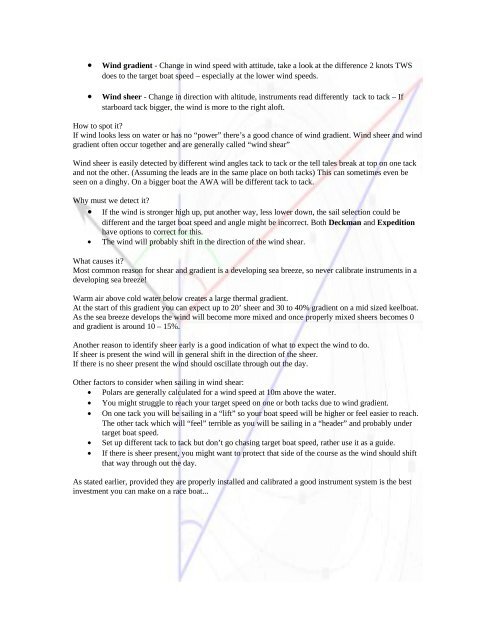Race boat instruments â understanding it all - L-36 Fleet
Race boat instruments â understanding it all - L-36 Fleet
Race boat instruments â understanding it all - L-36 Fleet
You also want an ePaper? Increase the reach of your titles
YUMPU automatically turns print PDFs into web optimized ePapers that Google loves.
• Wind gradient - Change in wind speed w<strong>it</strong>h att<strong>it</strong>ude, take a look at the difference 2 knots TWSdoes to the target <strong>boat</strong> speed – especi<strong>all</strong>y at the lower wind speeds.• Wind sheer - Change in direction w<strong>it</strong>h alt<strong>it</strong>ude, <strong>instruments</strong> read differently tack to tack – Ifstarboard tack bigger, the wind is more to the right aloft.How to spot <strong>it</strong>?If wind looks less on water or has no “power” there’s a good chance of wind gradient. Wind sheer and windgradient often occur together and are gener<strong>all</strong>y c<strong>all</strong>ed “wind shear”Wind sheer is easily detected by different wind angles tack to tack or the tell tales break at top on one tackand not the other. (Assuming the leads are in the same place on both tacks) This can sometimes even beseen on a dinghy. On a bigger <strong>boat</strong> the AWA will be different tack to tack.Why must we detect <strong>it</strong>?• If the wind is stronger high up, put another way, less lower down, the sail selection could bedifferent and the target <strong>boat</strong> speed and angle might be incorrect. Both Deckman and Exped<strong>it</strong>ionhave options to correct for this.• The wind will probably shift in the direction of the wind shear.What causes <strong>it</strong>?Most common reason for shear and gradient is a developing sea breeze, so never calibrate <strong>instruments</strong> in adeveloping sea breeze!Warm air above cold water below creates a large thermal gradient.At the start of this gradient you can expect up to 20’ sheer and 30 to 40% gradient on a mid sized keel<strong>boat</strong>.As the sea breeze develops the wind will become more mixed and once properly mixed sheers becomes 0and gradient is around 10 – 15%.Another reason to identify sheer early is a good indication of what to expect the wind to do.If sheer is present the wind will in general shift in the direction of the sheer.If there is no sheer present the wind should oscillate through out the day.Other factors to consider when sailing in wind shear:• Polars are gener<strong>all</strong>y calculated for a wind speed at 10m above the water.• You might struggle to reach your target speed on one or both tacks due to wind gradient.• On one tack you will be sailing in a “lift” so your <strong>boat</strong> speed will be higher or feel easier to reach.The other tack which will “feel” terrible as you will be sailing in a “header” and probably undertarget <strong>boat</strong> speed.• Set up different tack to tack but don’t go chasing target <strong>boat</strong> speed, rather use <strong>it</strong> as a guide.• If there is sheer present, you might want to protect that side of the course as the wind should shiftthat way through out the day.As stated earlier, provided they are properly inst<strong>all</strong>ed and calibrated a good instrument system is the bestinvestment you can make on a race <strong>boat</strong>...
















